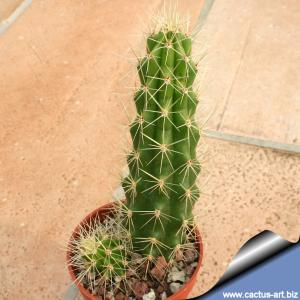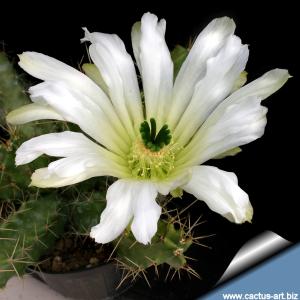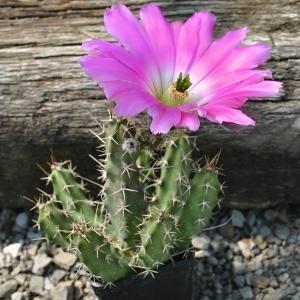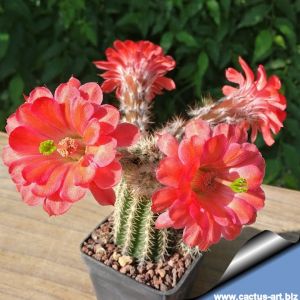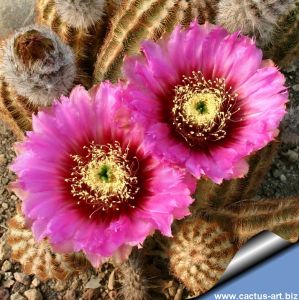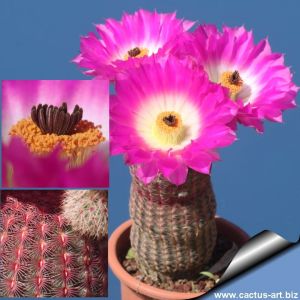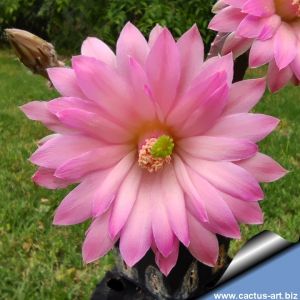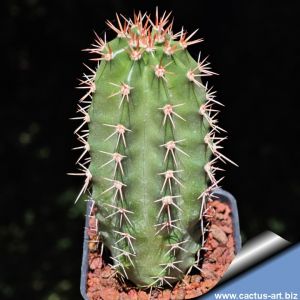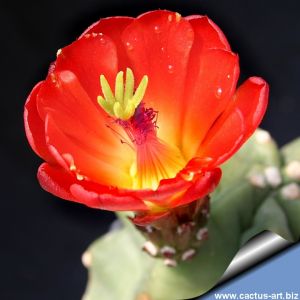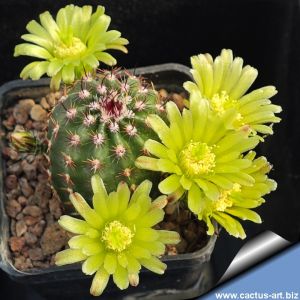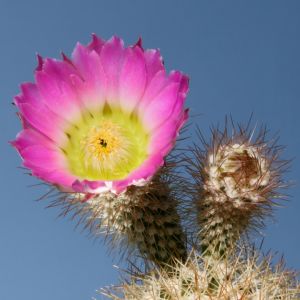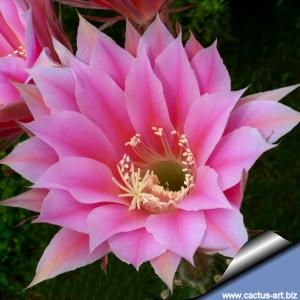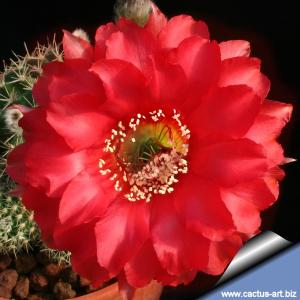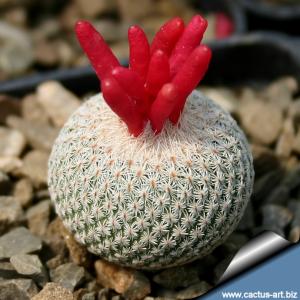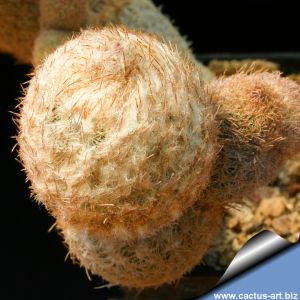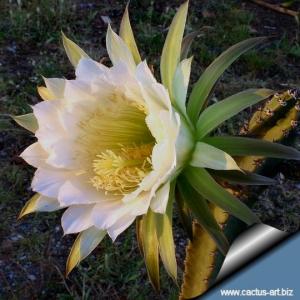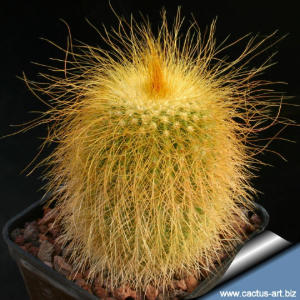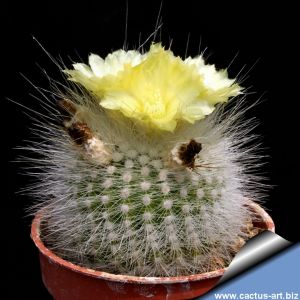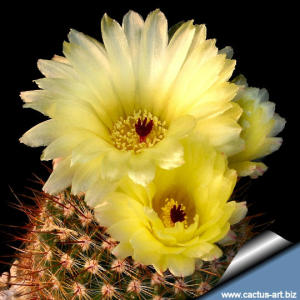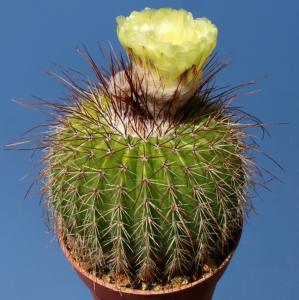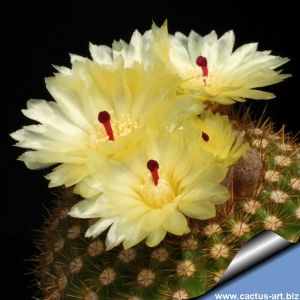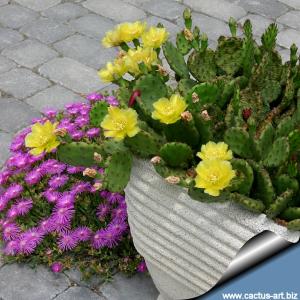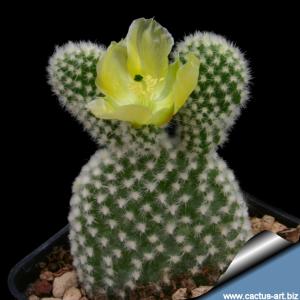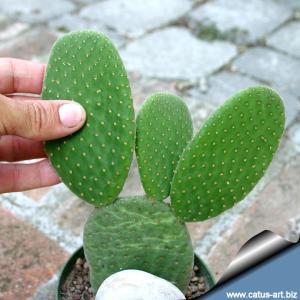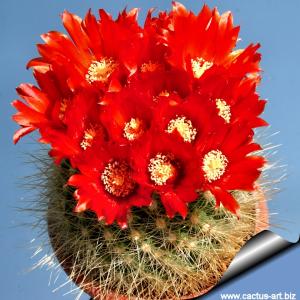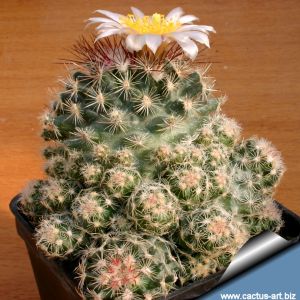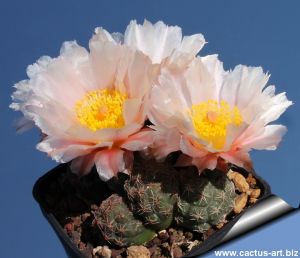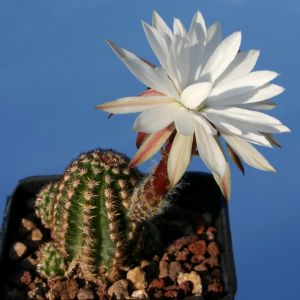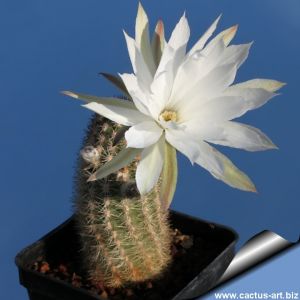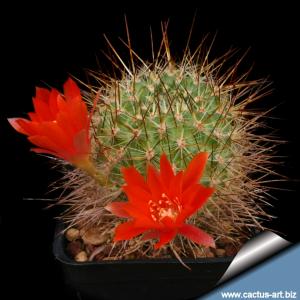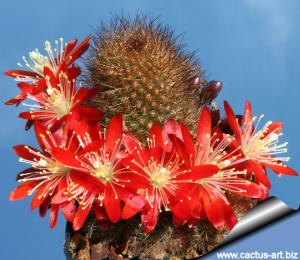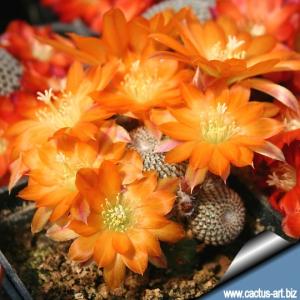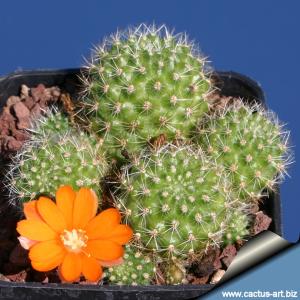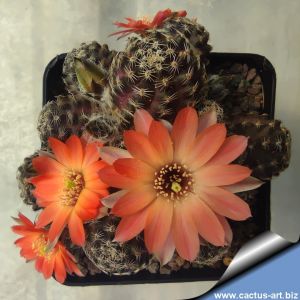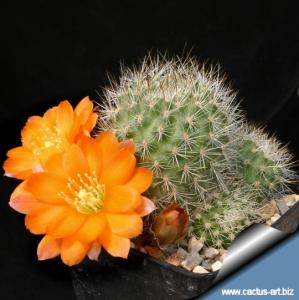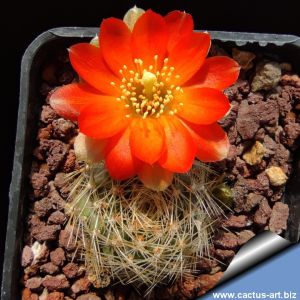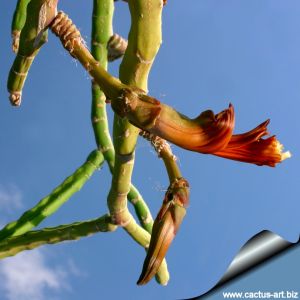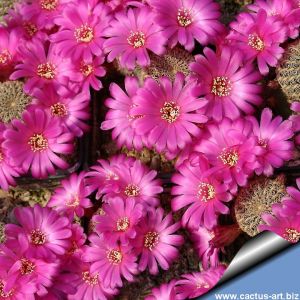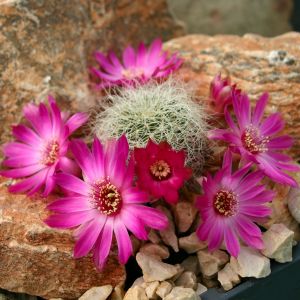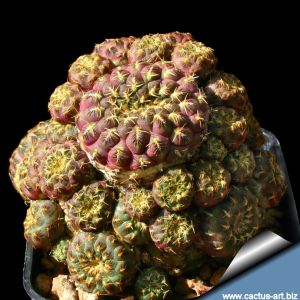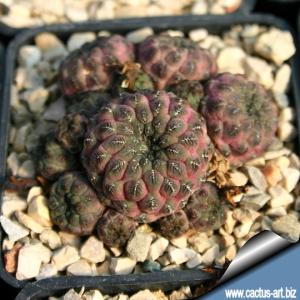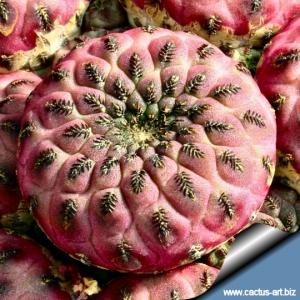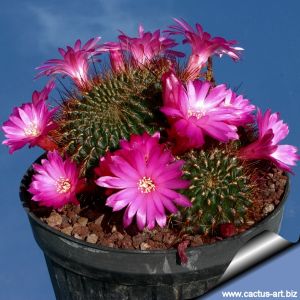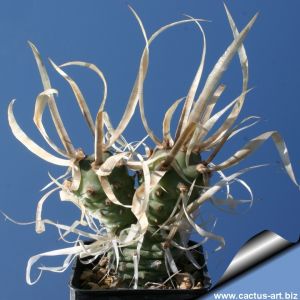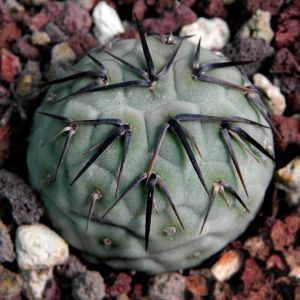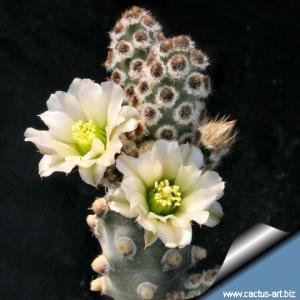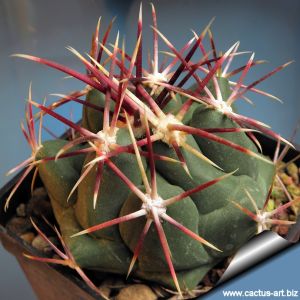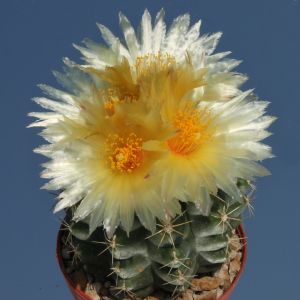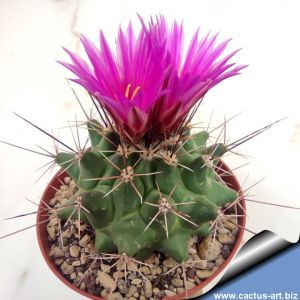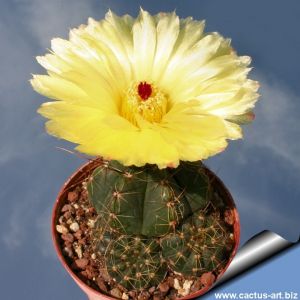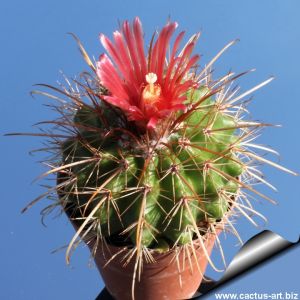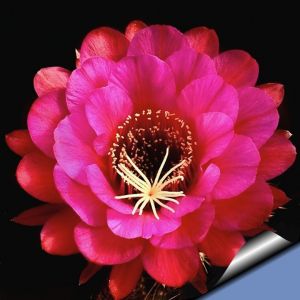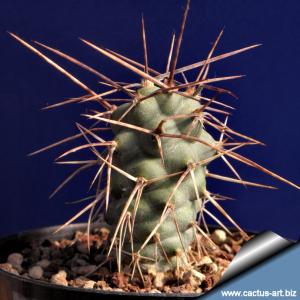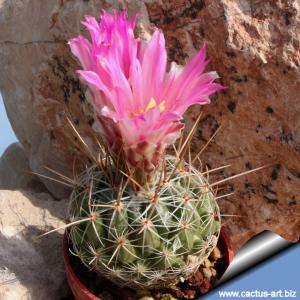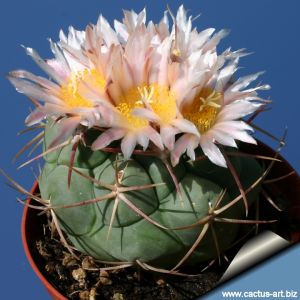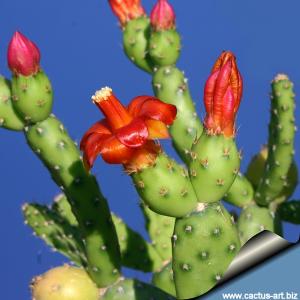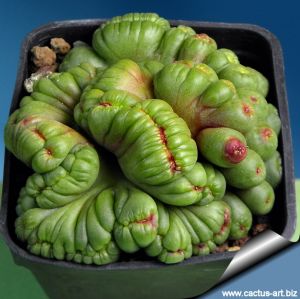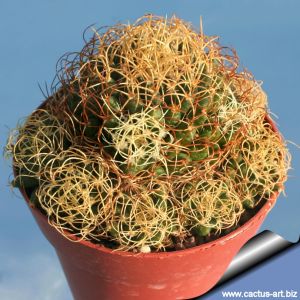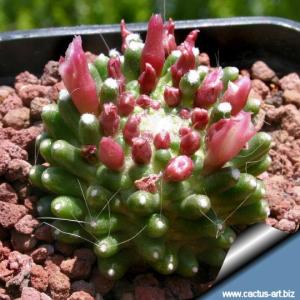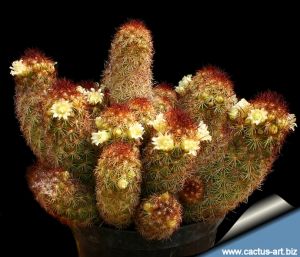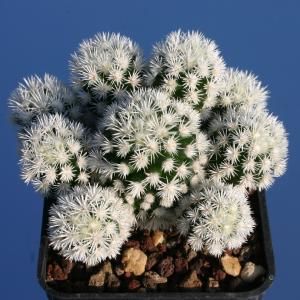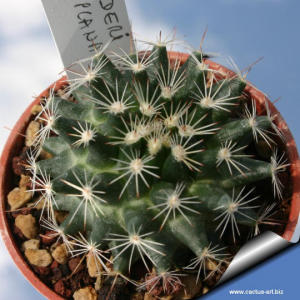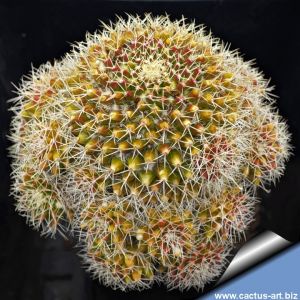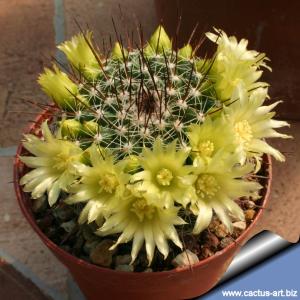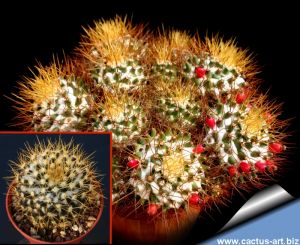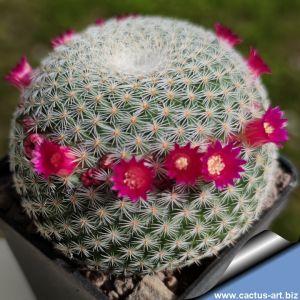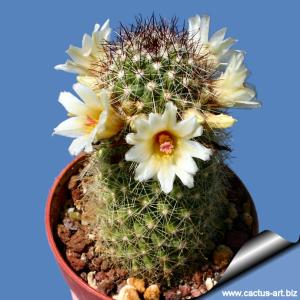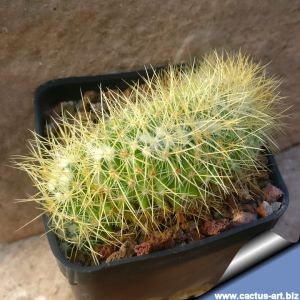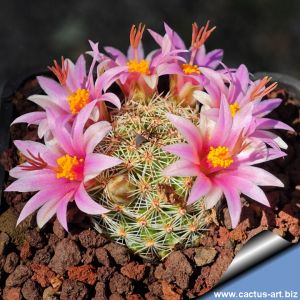-
1
It is a very untypical Echinocereus that does not take on the usual hedgehog shape. It is long and vine-like with slim, pendant sprawling stems, usually tangled with many branches up to 250 cm long. Rare in cultivation. Beautiful long orange-red flowers.
-
2
A magnificent cultivar bearing large white blooms, whose elegance is accentuated by a soft green throat, creamy anthers, and a deep green stigma—creating a harmonious and sophisticated contrast.
-
3
-
4
The long tubed flowers are a beautiful deep red. They bloom from April through June, and are very showy.
-
5
Solitary or few branche cylindrical stems. Radial spines, straight or slightly curved, lie close in two nearly pectinate series, white, beige, dull pink, brown, or purplish-black. Central spines often absent. Fragrant dark-purple flowers, 5–7 cm wide.
-
6
This is a "must have" plant for any collection, its attractiveness is in the unique pink and violet colour and density of its spines.
-
7
-
8
-
9
This is a very nice plant. The varietal name ‘inermis’ means unarmed, referring to the lack of spines.
The heavy and waxy flowers are red or orange with green stigma in the centre.
-
10
Echinocereus viridiflorus is a small, globular to cylindrical cactus with colorful spines and spring-blooming yellow-green funnel-shaped flowers. Its resilience to cold makes it a favorite among succulent enthusiasts in cooler climates.
-
11
It can grow as many as about 50 stems in a relatively large clump. They bloom from April through July, and are very showy. Blooming generally begins 7 to 10 years after sowing, as the plant matures. In cultivation it often grows for a long time solitary.
-
12
-
13
Blooms are dark scarlet about 10 to 11cm across with a subtle spicy fragrance. This plant is one of the most popular and appreciated Echinopsis cultivars by cacti enthusiast and hybridiser Bob Schick.
-
14
Tiny globose cactus with flattened, depressed top, appearing white-gray from dense microscopic spines. Small pink blooms yield bright red fruits that pop against the pale spiny body - a striking natural contrast.
-
15
Tiny, clump-forming species. Elongated, slender stems (1–3 cm in diameter) with beige spines; the longest emerge from a dense woolly apex and have rust-colored tips.
-
16
Harrisia jusberti is a night-blooming Cereus commonly known as "Queen of the night" It is a nice columnar cactus that produces huge nocturnal white flowers from spring to autumn.
-
17
Beloved for its long, thin, harmless golden spines. At maturity, it produces silky yellow flowers with petals that display a splendid, reflective shine.
-
18
A unique and beautiful species, certainly one of the most interesting Notocactus. This special selection shows long, soft, slender pure-white spines. Its silky, shiny yellow flowers enhance the elegance of this extraordinary plant.
-
19
This is a common ball cactus, very easy to cultivate. It has very nice russet to orangish coloured spines. Flowers are Lemon-yellow, up to 5 cm in diameter, with red stigma.
-
20
-
21
Parodia scopa subsp. succinea, also known as Notocactus succineus, features stems with abundant dark yellow central spines. Flowers are striking, glossy yellow with a bright red stylus and an intensely dark purple stigma.
-
22
Not frost tender. Plants are very cold-hardy, tolerating temperatures of -25°, they are also quite tolerant of winter wet. (In good drained soils). It can easily grows outdoors in central and southern Europe and will blooms freely.
-
23
Freely clustering succulent with miniature pads. It has no spines, but instead has numerous white hair-like glochids 2-3 mm long in dense clusters. O. microdasys may look soft and touchable, but don't!
-
24
Rare glochidless no prickly form, gentle to the touch. This touch friendly plant may be cultivated without any special care, and makes beautiful pot specimens. Distinctive and rare.
-
25
Spectacular species with glowing flame-red flowers which contrast well against the dense white spines.
-
26
OWN ROOTS. Diameter approx 5 cm. Freely offsetting selection - soon forms huge clumps.
It produces easily creamy-yellow flowers in spring.
-
27
This small geophytic opuntioid looks like a small Tephrocactus geometricus, but the bloom, fruit and the seeds clearly show its autonomous nature.
-
28
A pygmy cactus that offsets to form dense cushions of dozens of dark green, spherical to cylindrical heads. Its nocturnal, fragrant, funnel-shaped white flower can reach up to 6 cm in length.
-
29
Pygmaeocereus bylesianus is a diminutive cactus with short, dense rust-coloured spines and remarkably beautiful white nocturnal flowers which open for just a single night.
-
30
This is a nice clumping plants with lots of large orange red flowers from the lower stem. It has got very long and beautiful amber spines.
-
31
-
32
Its flawless arrangement of white spines and brown areoles keeps the plant attractive year-round, even when not blooming. A true essential for any cactus enthusiast!
-
33
-
34
Rebutia pygmaea is a very small clumping species. The flowers from the basal parts of the stem, usually are salmon pink, but may varies from white to pink, red, salmon and orange. It has a heavy tap root that may exceed the size of the plant above soil l
-
35
-
36
-
37
An exceptionally odd and eye-catching plant—essential for any collection of weird and monstrous specimens. With its cascading habit, it’s ideal for hanging baskets and requires minimal care to thrive and flower reliably. Unrootted cuttings.
-
38
Bellissima specie in miniatura, con abbondanti fiori magenta. Molto graziosa anche fuori fioritura. Con il tempo accestisce, formando grandi cespi compatti.
-
39
White, hairy spines, magnificent.
-
40
Very odd and different cultivar with violet body and short pectinated spines. Really a beautiful plant!
-
41
-
42
Beautiful super selected form with nice and distinctive dark violet body. Unique and unmistakable! Grown in a 6x6 cm square pot. OWN ROOTS.
-
43
A beautiful variety, sought after by collectors for its attractive mahogany red spines and rings of light purple flowers in spring (From the typical locality)
-
44
Outstanding harmless cactus with soft wide, papery spines. It will slowly growing up to up to 30 cm tall forming a segmented succulent bush.
-
45
This is one the best and very priced species.
-
46
Small spineless clumping segmented succulent, that grows as a small erect segment chains. Very ornamental with bright yellow-brown glochids and white felt. Flowers white.
-
47
This is one of most beautiful Thelocactus heavily armed with amber to red spines. But, unfortunately, this plant is supplied only, rarely, sometimes by the name T. pottsii. Big magenta flowers with a reddish throat in spring.
-
48
Free branching species that forms readily large clumps with several stems. Flowers yellow. Rare.
-
49
Grey-green stem, long greyish to yellow-brown spines. Flower pink to purple.
-
50
The plant's body take a nice purple-red colouring, hence the name rubescens (red)
-
51
Plants bearing long, sturdy hooked spines, coloured from yellow to brown to black. Areoles are white and woolly. Very easy to grow and flower. Truly beautiful!
-
52
-
53
-
54
-
55
Flattened greyish-green or bluish stems with very characteristic wide, polygonal-rounded tubercles (hexagonal or pentagonal at the base). Flowers silvery-white or pinkish.
-
56
Lovely plant with small segments that resemble those of a miniature Opuntia, but cylindrical and without glochids! It has only a few occasional short bristle-like spines and produces a profusion of rich orange flowers in profusion.
-
57
This plant has some really weird shapes and looks more like some non-cactus succulent or some strange green marine creatures.
It is an easy to grow cultivar, just as a classic cactus, don't requires any special treatment. ROOTTED CUTTINGS.
-
58
A.k.a. Bird's nest Mammillaria, this is a wonderful old favourite cultivar with curly golden-yellow spines. A plant soon forming many heads. The new growth is very attractive, the long, entwining yellowish spines soon form a mat. A real beauty.
-
59
It is a well known cultivar characterized by very reduced or absent spines, free branching, and with small pink flowers.
-
60
-
61
Solitary cylindrical or club-shaped stems, densely covered in short golden spines set in white woolly rings. Pale pink to red-purple flowers encircle the stem apex.
-
62
A sweet little mat forming plant, with long-lasting flowers and ornamental fruits. A very nice addition to any collection!
-
63
"Arizona Snowcap" shows an odd thickening and shortening of the spines, resulting in a most attractive, unusual candid white looking plants.
-
64
-
65
Initially solitary, the stem may branch or divide dichotomously as it matures. Spines spreading, straight, whitish with red-brown tips. Axils are woolly with white bristles. yellowish-white with reddish-browni tips.
-
66
After several years form very large clumps up to 1 m wide (space permitting!). Central spines straight, golden brown, reddish to almost black, sometimes absent. Flowers greenish-yellow.
-
67
This remarkable species features striking hooked spines and blooms with pale pink-white flowers in spring. The “cowperi” form is notable for its yellow-colored spines.
-
68
Mammillaria nivosa is one of the woolliest mammillarias, with beautiful golden-yellow spines. After several rounds of blooms earlier in the year, it produces strikingly bright red fruit. A truly beautiful cactus.
-
69
After several years the old plants divide at their apex, ramifying dichotomously (to form two or more distinct joints) and in 10-15 years they forms small colony. It is a pleasing sight, even in the depths of winter.
-
70
This is an unusual plant in collections that require acid organic soil.
It has cylindric to culumnar, pale-green stems up to 25-30 cm high solitary at first, later forming clusters from basal branches.
-
71
-
72
The dark orange/terracotta pistil is M. pseudoalamensis' trademark, differentiating
it from M. alamenesis' green pistil. Without flowers, the two plants are identical.

